How to manage stress in the workplace? This is one of the top concerns for organizations across the globe. The recent pandemic, emerging economic crisis, and the war in Ukraine have all been having a big impact on people.
The stress inevitably impacts employees’ motivation and productivity at work. Even though some people have shaped better connections with their employers during these trying times, many have been laid off or are in fear of being laid off in the future.
While some prefer remote work, many have been struggling to cope with social isolation. While younger generations may prefer asynchronous communication, older generations are finding it hard to adjust to all the new technologies implemented in their organizations.
Hence, workplace stress management has become a priority for many organizations that care about their employees’ experience and wellbeing.
So let’s take a look at some of the main causes and consequences of stress in the workplace and how to properly manage it.
📚 Before we move forward, get our brand new Employee Engagement Report 2022!
What Is Workplace Stress Management
APA’s annual Stress in America survey has consistently found that work is cited as a significant source of stress by a majority of Americans. Moreover, 83% of US workers suffer from work-related stress, with 25% saying their job is the number one stressor in their lives. This fact is concerning and would not be neglected by employers.
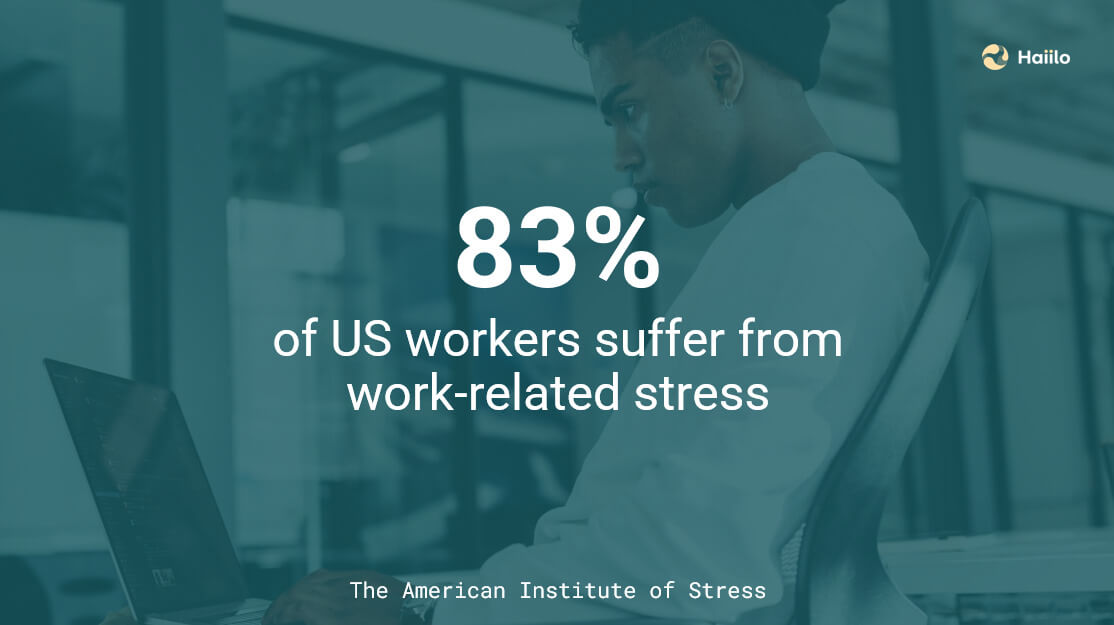
When stress in the workplace is persistent, it can cause serious consequences which we will cover later in this blog.
Workplace stress management, therefore, consists of all the activities and initiatives an employer takes to discover and prevent the main causes of work-related stress. It usually consists of different types of programs to improve employees’ experience in the workplace and to help them cope with stress.
This is why many organizations have been implementing formal employee wellbeing programs lately. They understand that their employees’ well-being has a direct impact on their engagement and productivity at work.
Top 9 Causes of Stress In the Workplace
Many different things can cause stress at work. However, research has proved that there are some major causes to it.
1. Low salary
Compensation and benefits have a high and direct impact on various HR-related KPIs. Whether it’s employee satisfaction, motivation, engagement, productivity, or retention, salary always plays an important role. This is no different when it comes to stress at work.
However, it is important to understand that higher-paying jobs which often bring more duties and responsibilities usually come with more stress.
2. Job insecurity
We live in an economy that is highly competitive, unstable, unpredictable, and volatile. This is especially true in light of the economic effects of the COVID-19 pandemic and the war in Ukraine.
These factors drive companies to lay off employees, creating job insecurity which results in higher levels of stress at work.
3. Poor workplace communication
When it comes to remote work, poor employee communication is one of the biggest struggles companies face. Inability to communicate synchronously makes employees feel like they are missing some critical company information.
Some are experiencing difficulties to collaborate efficiently with their team members which can lead to more stress at work.
💡 Related: 20 Ways to Engage and Connect with Your Remote Employees
4. Work overload and long working hours
Work overload and long working hours are often on the top of the list of causes of stress in the workplace.
The researchers at the City University of New York has discovered that long working hours are cited as the primary source of work-related stress by 21% of employees. This cause of stress is dangerous not only because of loss in productivity but it also tends to lead to stress-related illness and injury at work.
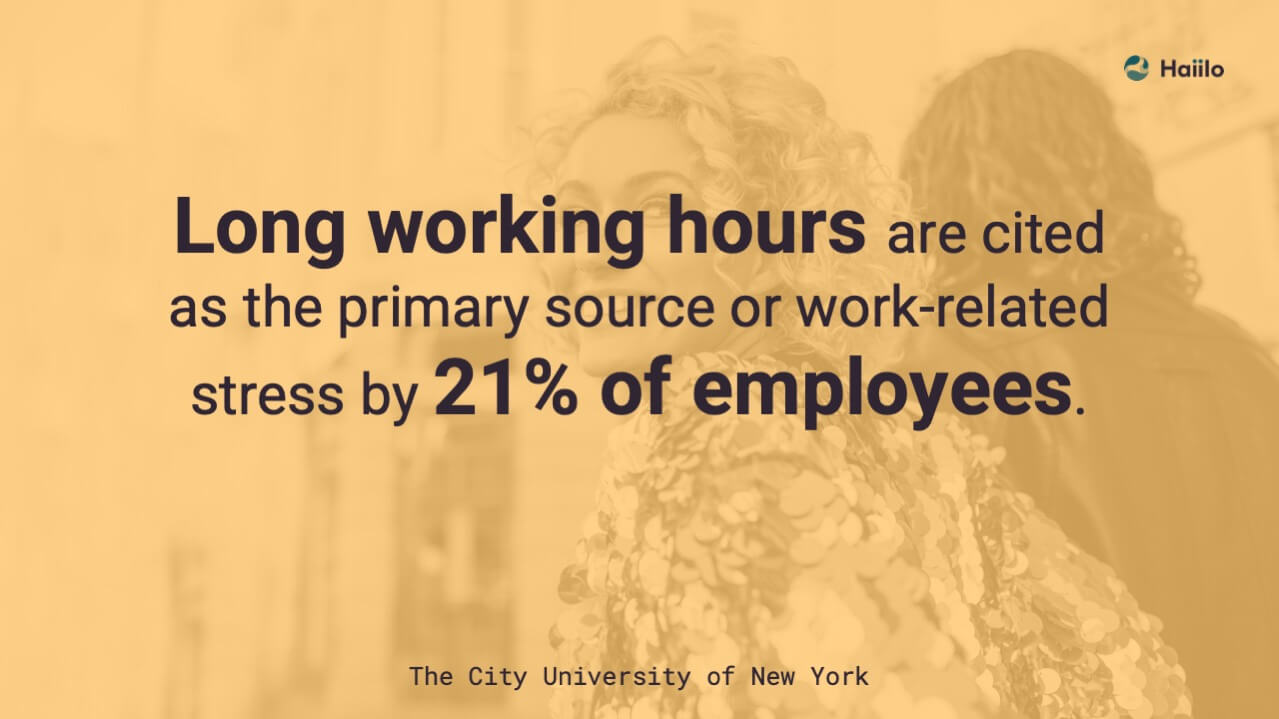
💡 Related: The Importance of Workplace Safety and How to Keep Employees Safe
5. Lack of autonomy and empowerment
Imagine working in an environment where your skills and experience are not leveraged enough, where your ideas are not taken into consideration, and where your voice is not heard.
In workplaces with such characteristics, employees tend to feel stressed and dissatisfied with their jobs.
6. Bad relationships and poor company culture
Company culture is one of the prevailing causes of stress, according to almost half of senior HR professionals surveyed in a popular poll that suggests significant differences in the ways employees and businesses view mental health in the workplace.
According to that pool, 45% of HR professionals believed their organizational culture caused stress, although 40% said they were working to create a ‘caring and inclusive culture.
💡 Related: Diversity and Inclusion Best Practices to Focus on in 2022
7. Inappropriate change management
Most people are resistant to change. Yet, many organizations have been facing continuous changes in the past few years. In order to ensure business continuity, companies need to be agile. They need to adopt best change management practices and adjust to the ever-changing business environments.
All these changes, digital transformation being a common one, require employees to adjust and embed new behaviors. If these changes are not managed properly, they can be a major source of stress.
8. Poor leadership and management
Good leadership is crucial for managing stress in a workplace. Leaders are the ones who can inspire people and encourage them to work together towards achieving a common goal.
Managers are the ones who are responsible for building good relationships with and among their team members and motivating them to do great work.
Therefore, when management and leadership are poor, the chances for higher stress at work are much bigger.
9. Inappropriate/insufficient workplace technology
Today’s workplaces are highly digital and we depend on technology to do our jobs successfully. In the last few years, many organizations have been adding numerous workplace tools hoping to enable their people to be more productive.
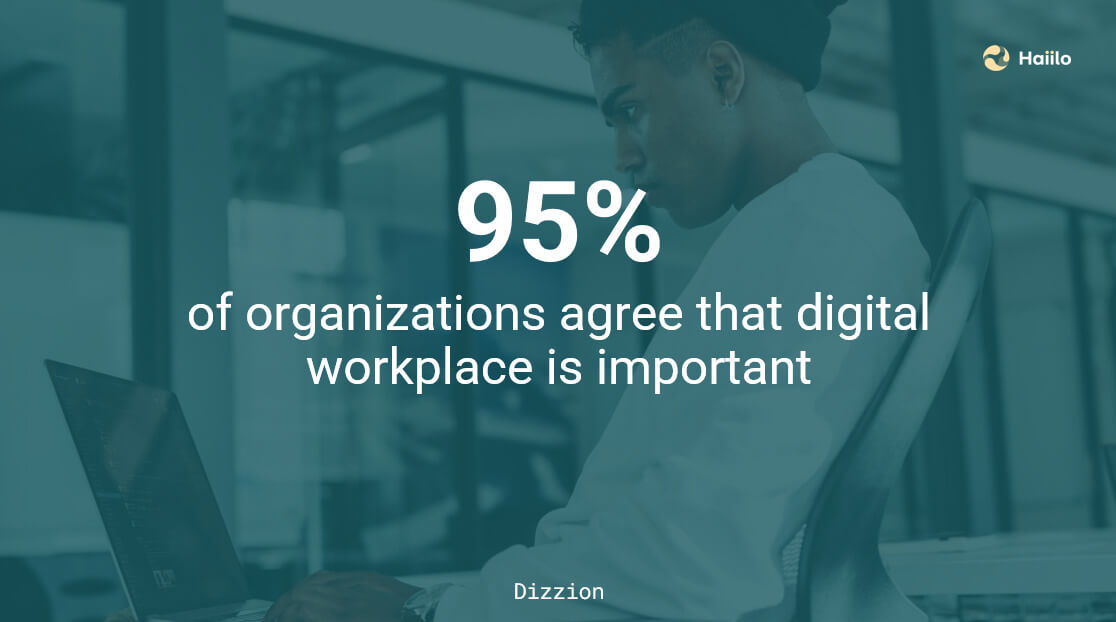
Adding too many different solutions can, however, be contra-effective. In the sea of software for employee communication, video calling, employee engagement, project management, learning and development, document sharing, and others, employees tend to get lost and frustrated.
So workplace tech, especially when not integrated properly, can be a big source of stress at work.
Top 5 Consequences of High Stress In the Workplace
Earlier, we talked about how workplace stress management is a big priority for many employers. Why? Well because the consequences of work-related stress are numerous and serious. In fact, all the factors that impact employee experience in the workplace can also cause stress. When employee experience is poor, people will probably feel some kind of stress.
So let’s take a look at some of the most concerning ones.
1. Poor employee health and wellbeing
Even though the consequences of high stress levels at work can be numerous, employees’ health is the most concerning one. Unfortunately, all the research done in this area is more than worrisome.
Stress Management Society reported that workplace stress is linked to 70% of visits to the doctor and 85% of serious illnesses.
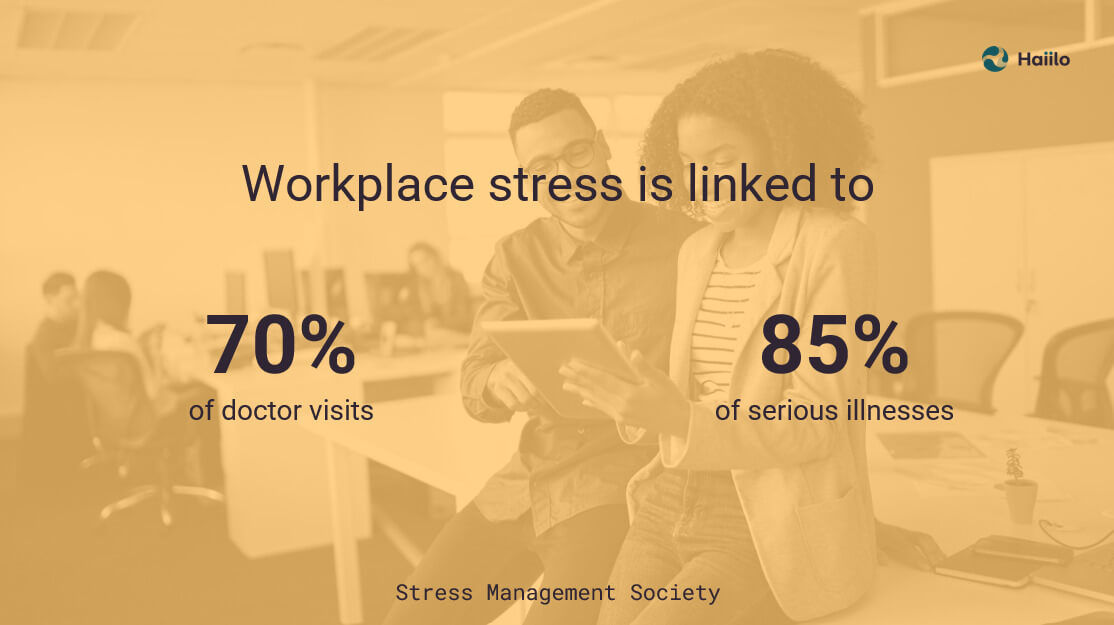
Poor mental and physical health caused by workplace stress negatively impacts people’s personal lives – many employees pick up unhealthy habits such as alcohol, prescription pain medication, and other substances.
2. Low employee engagement and productivity
According to the American Institute of Stress, more than 50% of workers are not engaged at work as a result of stress. In another research, 41% of workers said stress made them less productive, 33% said it made them less engaged.
Managing such stress is of utmost importance to employers as it directly impacts employees’ work quality. According to Deloitte, 91% of employees said that feeling overwhelmingly stressed negatively affects the quality of their work
3. High employee turnover
When stress leads to a loss in engagement and productivity it naturally impacts turnover rates in an organization. These leaves can be either voluntary or involuntary.
In a previously mentioned research, 15% of employees admitted they were looking for a new job because of the stress they experience at work. This percentage is extremely big, and workplace stress can be considered as one of the main causes of employee turnover and low retention.
In the past few years, we have been living in the era of great resignation, which proves that the pandemic and the current world situation have been leading to higher levels of stress at work.
4. Increased employee absenteeism
Previously mentioned research by the American Institute of Stress showed that about one million Americans miss working each day because of stress. And depression-induced absenteeism costs US businesses $51 billion a year, as well as an additional $26 billion in treatment costs.
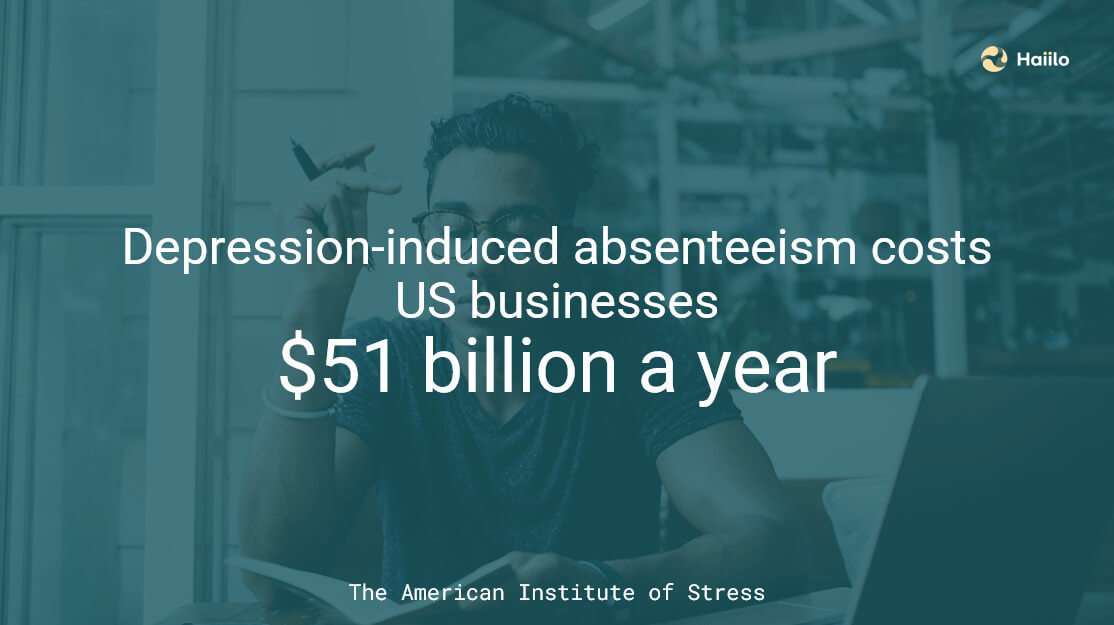
5. Poor employer brand
Same as customers, unhappy employees tend to be much louder than happy ones. When dealing with work-related stress, employees share their feelings and thoughts with family and friends via online and offline channels.
This can seriously impact the organization’s reputation as an employer, weaken its employer brand, and make it harder to attract and hire new talent.
Workplace Stress Management Best Practices
In a recent article, SHRM reported that only 35% of employees say that they receive sufficient resources to cope with and manage stress at work. Given that work is becoming more and more stressful for people, this percentage is concerningly low.
So what can employers do to improve workplace stress management in their organizations? Let’s take a look!
1. Find the biggest sources of stress
In order to improve workplace stress management, the first step is to understand the main and biggest sources of stress among employees.
The best way to do so is by asking employees directly. This is the best way to find stress sources and also to encourage employees to share their voice, and raise their fears, concerns, and opinions.
Short and regular employee surveys are the best way to collect such information in the workplace. Make sure that the surveys are intuitive and available to every employee on any device.
2. Reassess your company culture and provide more flexibility
Have you reconsidered your company’s culture, core values, and value proposition in the past 3 years? If not, you should probably do so. Times have changed, and employees’ expectations have changed as well.
If, for example, job flexibility in terms of working hours and locations hasn’t been addressed yet, you should consider it. Today, employees expect more flexibility at work and lack of flexibility can be one of the big sources of stress.
3. Raise internal awareness
This step is crucial!
Educating employees and managers about how to cope with stress is very important for mastering workplace stress management.
Clear, consistent, and frequent organizational communication is a must as this is the only way to inform and encourage employees to take stress seriously and to help them identify their own stress triggers at work.
Consider implementing an employee wellbeing program where you can provide useful information about stress management or offer therapies designed to help people deal with stress at work.
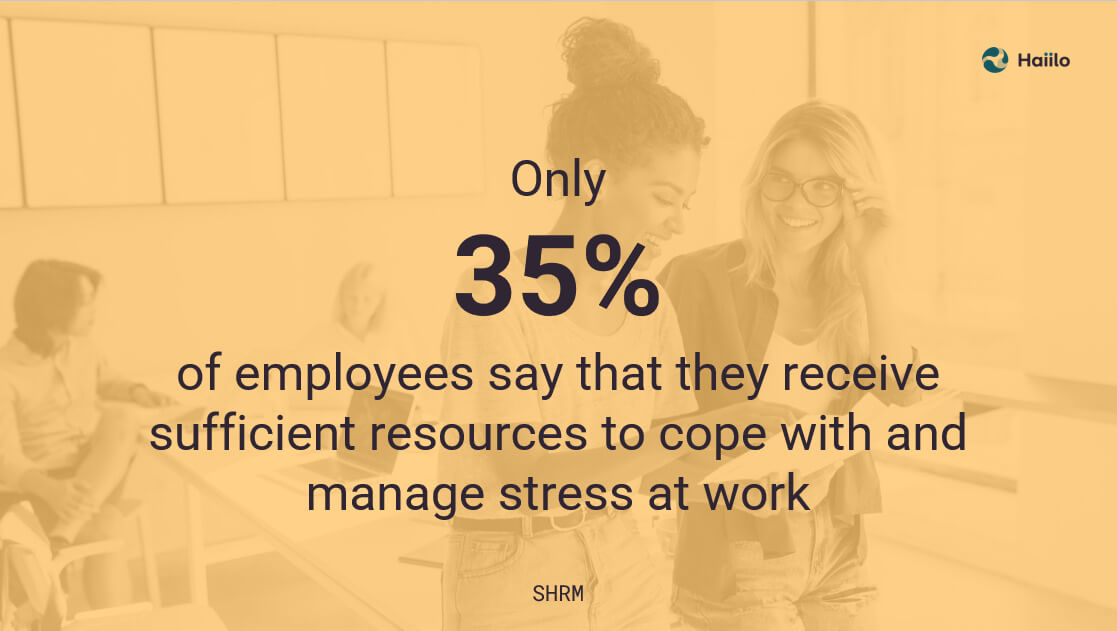
You can also create designated channels and communities where people can connect and share their own experiences and best practices about stress management.
4. Stay competitive!
Earlier, we mentioned that low compensation and poor benefits can cause stress at work. Hence, make sure that you analyze the market frequently and stay competitive.
Learn about the benefits your employees care the most about and make sure that you offer attractive compensation packages.
5. Provide the right workplace technology
Make sure that your employees and managers have all the necessary tools to be the best versions of themselves at work. Ensure that these technologies are well integrated and intuitive for your multigenerational workforce.
Today, workers spend less time interacting with other workers throughout the day. In reality, there is significantly less human interaction on all levels. Emails, voice mails, text messaging and video conferencing make many workers feel stressed, alone and isolated.
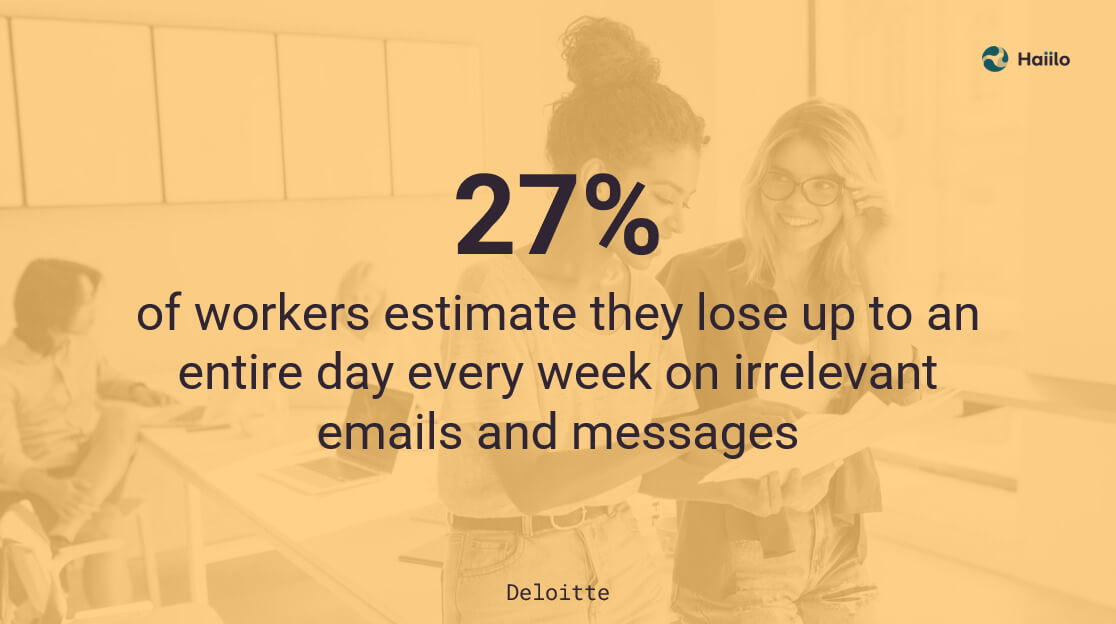
So enable your employees to communicate and collaborate properly, have access to important information and documents at all times, share their voices and concerns, and stay aligned with your company culture, strategy, and goals.
Interesting Facts About Stress In the Workplace
A recent research by stress.org was eye opening for many employers. Work is the main stressor for many people, and here are some of the most interesting findings from the research:
- 80% of workers feel stress on the job, nearly half say they need help in learning how to manage stress and 42% say their coworkers need such help
- 40% of workers reported their job was very or extremely stressful
- 25% view their jobs as the number one stressor in their lives
- 75% of employees believe that workers have more on-the-job stress than a generation ago
- Some 57% of U.S. and Canadian workers reported feeling stress on a daily basis
- 19% or almost one in five respondents had quit a previous position because of job stress and nearly one in four have been driven to tears because of workplace stress
This isn’t the only research that proved the consequences of the poor workplace stress management. Here are some other findings:
- 80% of workers say work-related stress affects their relationships with colleagues, friends, and families. (MHA)
- Most common causes of workplace stress are workload (44%), lack of support (14%), changes at work (8%). (HSE)
- Some other common stress factors are low salaries, lack of opportunity for growth, unrealistic job expectations, and long hours. (SHRM)
- More than two in five workers say that lack of participation in decision-making and problems with supervisors and colleagues also contribute to stress at work. (APA)
- Front-line workers (67%) are more likely to experience negative impacts of stress compared to middle-level (64%) and upper-level employees (54%). (APA)
It is, hence, clear that stress can be one of the biggest culprits for low employee engagement, morale, and productivity at work. So employers certainly need to do a better job managing stress in their organizations.









